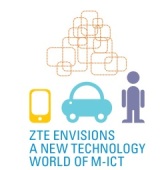ZTE: New branding, same prospects
 Monday, January 5, 2015 at 5:35PM
Monday, January 5, 2015 at 5:35PM ZTE has ushered in the New Year with new look, a new slogan and a new philosophy.
Corporate rebranding is an easy target for snark, especially in the New Year void, and ZTE isn’t helping matters by declaring ‘cool, green and open’ as its new corporate values.
But it’s worth reflecting on the prospects of the smallest global vendor at a time when its nearest competitors are said to be contemplating a merger. Does a minnow like ZTE have a future at all?
 Some foreign execs think the only reason for its existence is to provide competition for Huawei, its all-conquering rival from the other side of Shenzhen.
Some foreign execs think the only reason for its existence is to provide competition for Huawei, its all-conquering rival from the other side of Shenzhen.
Staff at both vendors hate comparisons as much as they apparently loathe each other, but the contrast between two firms that have been competing in the same business in the same city for nearly three decades is irresistible.
For one thing, Huawei is privately-held and unlisted, while state-owned ZTE is listed on the Hong Kong and Shenzhen bourses.
In 2013, the last full year reported, Huawei racked up $39 billion in sales and ZTE just $12 billion. That gap that almost certainly widened in 2014. Reuters reports that Huawei’s device business alone tallied $11.5 billion in 2014.
If we strip out the other revenue, ZTE weighs in at a puny $6.5 billion in 2013 network sales, barely a quarter of Huawei’s. And that’s with the aid of the China 4G rollouts (which by the way boosted its carrier product margins by a healthy ten points).
The company deserves some recognition for its revival in the past 18 months but it’s difficult to see a breakout from its current model.
It sells network gear to China and emerging market operators, often countries friendly to China, occasionally sweetened by generous state bank credit lines. It's building the cloud radio and SDN/NFV solutions that everyone else is, but doesn't have the R&D heft to become a frontrunner.
Likewise in smartphones, it's shipped some decent products but they don’t generate the same excitement or sales as Xiaomi’s or Huawei’s, leaving it to slug it out with the also-rans.
But while ZTE is not going to grow like Xiaomi, there are reasons to be cheerful.
After China's 4G rollouts peak this year it will have the 4G business in the developing markets to forage on, as well as the steady demand from operators and consumers for its devices. Its unique position as a small but privileged player in a huge market means its new logo will be with us for awhile yet.
 Huawei,
Huawei,  ZTE in
ZTE in  China Vendors
China Vendors 
Reader Comments (1)
Thanks for a very insightful blog! You mention ZTE got a 10 point carrier product margin increase from 4G rollouts - would you be able to help point where this is reported?